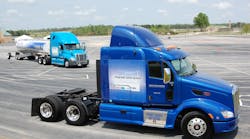Making commercial vehicles more efficient yet safer simultaneously are two of the most critical technological challenges facing the trucking industry in the near future, according to interviews with executives at Meritor and Meritor WABCO – in no small part due to a host of ever-higher operational costs.
“There is just so much pressure to deliver more fuel economy today because [trucking] businesses need to be more cost efficient; they need to save money where they can,” Jon Morrison, president and GM for Meritor WABCO, told Fleet Owner at the joint “Scientific Savings” Expo held jointly by both firms this week at the Atlanta Motor Speedway for 50 customer fleets.
[To view photos from the "Scientific Savings" Expo event, click here.]
“Yet at the same time being safe is much more critical than it’s ever been in this industry, and not just because of the new CSA [Compliance Safety Accountability] regulations,” he stressed. “Because being safer offers its own efficiency and cost savings benefits to fleets as well, along with reducing risk exposure.”
That’s why Meritor and Meritor WABCO are planning to hold a series of “technical events” like the one in Atlanta this week across the country, noted Jay Craig, Meritor’s senior VP and president of its commercial truck and industrial business: to put engineers from both companies together with end users in order to discern what kinds of solutions are needed by the industry.
“The key is really using innovation to solve the problems faced by this industry,” he said. “We’re doing these events because we need to get closer to our OEM and trucking customers so we get real-world input into our engineering efforts. We need to expose them to the technologies we have so we can get from them critical feedback to see if our products help address their needs.”
For example, Meritor is in the process of set up winter testing for an automatic tire inflation system for tractors – similar to the Meritor Tire Inflation System by PSI for trailers – with customers right now, Craig said, in order to elicit “direct feedback” on whether such technology will prove to be help their business or not.
“We can always build a better mousetrap, but if it’s not what our customers need, then we’re wasting time and money for the both of us,” added Timothy Burns, Meritor’s VP-North America. “We also understand that people don’t like change; they don’t like giving up what they’re used to. So we also need to better explain the opportunities that change offers as well.”
Burns pointed to antilock braking system (ABS) technology as an example. “It wasn’t widely accepted by the trucking industry for the first four of five years it was commercially available; drivers in particular didn’t like it because it changed the ‘feel’ of the brakes and changed how they needed to use them,” he said.
But after it became technology mandated by the federal government, he stressed that ABS provided the platform upon which a whole new level of safety technologies could be developed: rollover prevention systems, stability control, and collision avoidance systems.
Indeed, a similar situation may be developing where stability control technologies are concerned, added Mark Melletat, director of field operations for Meritor WABCO, as the National Highway Transportation Safety Administration (NHTSA) is expected to issue the final version of its stability control mandate sometime in the fall this year; a rule that would go into full effect sometime in 2016.
Yet Meritor WABCO’s Morrison stress that, at the end of the day for fleets, some form of “value” must be extracted from the use of any new technology, regardless of whether it’s designed to improve vehicle safety, reduce weight, or boost fuel economy.
“The challenge is always ROI [return on investment] which is really linking payback – which is a crude term – to whatever we are doing for the customer,” he explained. “What complicates that calculation is not every fleet is the same, so it comes down to matching the right technology or groups of technologies to specific applications in order to obtain that ROI.”



